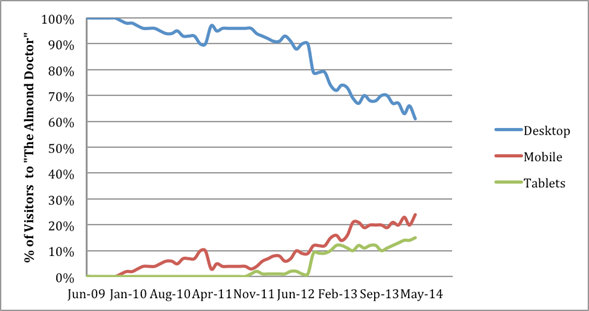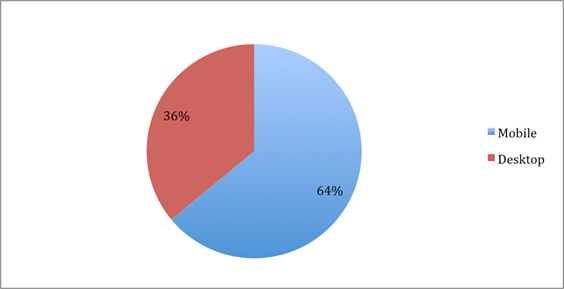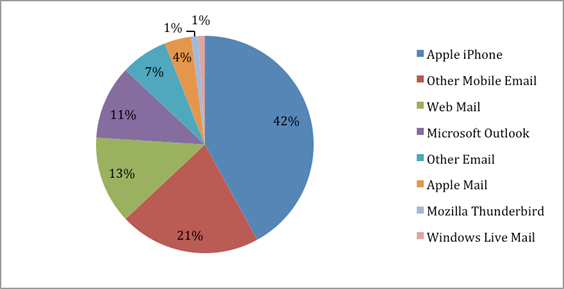 |
December 2014
|
December 2014 // Volume 52 // Number 6 // Tools of the Trade // v52-6tt3
Extension Must Adopt Mobile-Friendly Websites
Abstract
Mobile phones and tablets have become important tools for accessing information on the Web. We have found visitors to The Almond Doctor Extension blog and AgFax.com are increasingly using smart phones and tablets rather than desktop computers. However, only 40% of Extension websites have mobile-friendly layouts, and websites that are frustrating to use on mobile devices may be a deterrent to Web traffic and use of services. Therefore, it is critical for Extension websites to develop mobile-friendly designs to increase Extension's presence on the Internet and maintain its relevance to current and future clientele.
Extension Clientele Are Adopting New Technology
Diem, Hino, Martin, and Meisenbach (2011) found Extension personnel believed clientele were reluctant to adopt new technology, which deterred redevelopment of education and outreach programs to accommodate changes in technology. This perception was based on the fear that new technologies would compromise conventional Extension programming by redirecting resources and driving away traditional audiences. However, as Diem et al. (2011) noted, this perception is misplaced because clientele are using technology to access information. For example, 75% of farmers now have access to computers (USDA NASS, 2013), and online Extension courses have proven successful (Green, 2012).
Mobile computing, via smartphones and tablets, is a technology with considerable potential for Extension agencies and clientele. Fifty-eight percent of all adults have smartphones, and 63% use their phones to access the Internet, with mobile Internet usage as high as 85% for adults under 30 (Pew Research, 2014; Duggan & Smith, 2013). Here we present evidence of increased viewing of two popular Extension and agriculture websites on mobile devices relative to desktop computers and why adapting Extension websites to accommodate mobile devices is critical to increasing Extension's presence on the Internet.
Mobile Devices Are Supplanting Desktop Viewing of Extension and Ag Websites
The Almond Doctor (http://thealmonddoctor.com/) is a blog about tree nut production and orchard management written by University of California Cooperative Extension farm advisors. The blog addresses questions asked by farming clientele, and is read by an estimated 60% of California's almond industry annually. Since the blog's inception in 2009, pageviews from mobile phones and tablets have increased to 40% of relative traffic, with a concomitant decline in traffic from desktop computers (Figure 1). The majority of mobile users are accessing the website via Apple iPhone (40%) and iPad (35%) devices, while the remainder use Android (23%) or Windows 8-based platforms (Figure 2). AgFax Tree Crops is one of several weekly email newsletters published by AgFax Media (http://agfax.com/). Taylor (2012a,b) previously noted the rise in mobile newsletter readership. More recent data indicates 64% of AgFax Tree Crops subscribers now access the newsletter from a mobile device (Figure 3), 42% of which are reading from an iPhone (Figure 4).
Figure 1.
Devices Used to Access The Almond Doctor Website from June 2009 Through May 2014
Figure 2.
Mobile Devices Used to Access The Almond Doctor Website in May, 2014
Figure 3.
Devices Used to Access and Open Email Subscriptions of AgFax Tree Crops from Newsletters Sent in April, 2014
Figure 4.
Mobile Devices and Desktop Email Software Used to Open and Read the Weekly AgFax Tree Crops Newsletters Sent in April, 2014
Delivering Information on Mobile Devices
The data suggest Extension clientele are showing an increasing preference for obtaining information via mobile devices. Are these and other Extension and agriculture-related websites optimized for mobile platforms? If not, would lack of mobile-friendly sites discourage continued clientele use? Smaller screens, touch-based interfaces, and slower connections make accessing Web information on mobile devices fundamentally different from desktop computers (Nielsen, 2012a). Unless the website is optimized for mobile devices, navigating menus, links, and documents on traditional websites can be challenging.
Websites are mobile-optimized by use of a separate mobile application (app), or through a browser-accessed website designed for improved mobile viewing. Drill (2012ab, 2013) described potential uses of mobile apps in Extension, while others have developed apps for specific Extension-related functions (Rusche & Renelt, 2014; Dietz & Dickson, 2013; Hansen & Purcell, 2012; Beckerman & Sadof, 2011; McCullough, Waltz, Hudson, & Martinez-Espinoza, 2011). While providing superior usability (Nielsen 2012a), mobile apps must be designed and developed for specific tasks, which can require considerable investment of time and money. App developers must also contend with getting an app approved for distribution in an app store.
Mobile-friendly versions of websites are an alternative to developing apps. Mobile websites have simplified designs and larger interface elements that make navigation with touch-screens easier. Because mobile websites are accessed through a Web browser, there is no need to develop an app. Nielsen (2012b) suggests building reduced, simplified mobile websites that contain only content used by most visitors, most of the time, so long as a link to the full website is provided for more specialized tasks. However, Faletski (2012) argues that having separate websites for different types of devices "Balkanizes" the Web with unequal content and suggests device-specific webpages may not rank as high as traditional webpages on search engine queries (Gunelius, 2013; Faletski, 2012; Nielsen, 2012b). Instead, Faletski (2012) and others (Gunelius, 2013; Lawson, 2012) advocate for "responsive design," wherein a single website looks and functions similarly across all devices.
Extension Websites Must Become Mobile Friendly
We surveyed 51 U.S. Extension agency websites and found only 20 homepages exhibited some degree of mobile-friendly design. Beyond the homepage, mobile friendliness was varied and incomplete. For example, some agencies have some mobile-friendly sections, but other critical webpages, such as Integrated Pest Management programs, were cumbersome to use on mobile devices. A mobile IPM webpage would enhance usability when diagnosing pest and disease problems in the field. Other Extension agencies have mobile-friendly menus, but ultimately only direct users to conventional PDF factsheets. While cross-compatible, downloadable, and printer friendly, PDFs are poorly suited for mobile use because their typical two-column layout requires unwieldy scrolling and "pinching" magnification to read (Taylor 2012b). Some agencies overcome this problem by displaying factsheet information in both web- and printer-friendly formats.
To maximize usability and increase traffic, Extension agencies should thoroughly overhaul their websites to become more mobile friendly. Google, Sterling Research, and SmithGeiger (2012) survey data suggests 65% of mobile users are more likely to use a service if the site was mobile friendly and that 43% become "frustrated or annoyed" if a site is not mobile friendly, making them 59% less likely to use a service altogether. Therefore, at a minimum, Extension IT management should prioritize redesigning the components of their websites most likely to be viewed on mobile devices.
Extension has had a problematic history with the Internet. The goals, mission, and programs that Extension offers are virtually unknown to younger clientele (Rader, 2011,; Loibl, Diekmann, & Batte, 2010), a problem likely rooted in Extension's relative unpopularity in the Internet (Rader, 2011). ABM AgriMedia Council (2014) found that 23% of farmers visit mobile agriculture websites or use ag-related apps (20%) on a weekly basis, increasing to 46% and 38%, respectively, for farmers under age 45. We therefore strongly suggest Extension agencies prioritize accommodating mobile devices to reach existing and future clientele. As a repository and engine of research-based information, Extension must become the "go to" place for agricultural, gardening, nutrition, and natural resource information on the Web and do so without sacrificing successful in-person outreach programs.
References
ABM AgriMedia Council (2014). 2014 media channel study. Retrieved from: http://www.abmassociation.com/images/abm/Committees/To%20be%20Distributed%20-%20Agri%20Media%20Council%202014%20Report%20v2.pdf
Beckerman J. L., & Sadof, C. S. (2013). Caught with your plants down? There's an app for that! Journal of Extension [On-line], 51(2) Article 2TOT3. Available at: http://www.joe.org/joe/2013april/tt3.php
Diem, K., Hino, J., Martin, D., & Meisenbach, T. (2011). Is Extension ready to adopt technology for delivering programs and reaching new audiences? Journal of Extension [On-line], 49(6) Article 6FEA1. Available at: http://www.joe.org/joe/2011december/a1.php
Dietz, M., & Dickson, D., (2013). Encouraging rain garden installation with a Smart Phone App. Journal of Extension [On-line], 51(2) Article 2TOT2. Available at: http://www.joe.org/joe/2013april/tt2.php
Drill, S. (2012a). Mobile applications for Extension. Journal of Extension [On-line] 50(5) Article 5TOT1. Available at: http://www.joe.org/joe/2012october/tt1.php
Drill, S. (2012b). Tools for creating mobile applications for Extension. Journal of Extension [On-line], 50(6) Article 6TOT1. Available at: http://www.joe.org/joe/2012december/tt1.php
Drill, S. (2013). Mobile Applications for Participatory Science. Journal of Extension [On-line], 51(1) Article 1TOT1. Available at: http://www.joe.org/joe/2013february/tt1.php
Duggan, M., & Smith, A., (2013). Cell Internet use 2013. Retrieved from: http://www.pewinternet.org/2013/09/16/cell-internet-use-2013/
Faletski, I. (2012). The future of the Web: The case for responsive design. Retrieved from: http://www.forbes.com/sites/ericsavitz/2012/12/27/the-future-of-the-web-the-case-for-responsive-design/
Google, Sterling Research, & SmithGeiger (2012). What users want most from mobile sites today. Retrieved from: http://static.googleusercontent.com/media/www.google.com.au/en/au/events/thinkmultiscreen/pdf/gomo-study-australia-logo.pdf
Green, S. (2012). Extension online: Utilizing technology to enhance educational outreach. Journal of Extension [On-line], 50(5) Article 5TOT4. Available at: http://www.joe.org/joe/2012october/tt4.php
Gunelius, S. (2013). Why you need to prioritize responsive design right now. Retrieved from: http://www.forbes.com/sites/work-in-progress/2013/03/26/why-you-need-to-prioritize-responsive-design-right-now/
Hansen, G., & Purcell, S. (2012). A smartphone application for landscape plants: A case study and guide to developing a decision-making application. Journal of Extension [On-Line], 50(6) Article 6TOT2. Available at: http://www.joe.org/joe/2012december/tt2.php
Lawson, B. (2012). Why we shouldn't make separate mobile websites. Retrieved from: http://www.smashingmagazine.com/2012/04/19/why-we-shouldnt-make-separate-mobile-websites/
Loibl, C., Diekmann, F., & Batte, M. (2010). Does the general public know the Extension service? A survey of Ohio residents. Journal of Extension [On-line], 48(2) Article 2RIB3. Available at: http://www.joe.org/joe/2010april/rb3.php
McCullough, P. E., Waltz, F. C., Jr., Hudson, W., & Martinez-Espinoza, A. D. (2011). Turfgrass management at your fingertips: Information delivered through "smart" phone technology. Journal of Extension [On-line], 49(3) Article 3TOT10. Available at: http://www.joe.org/joe/2011june/tt10.php
Neilsen, J. (2012a). Mobile sites vs apps: The coming strategy shift. Retrieved from: http://www.nngroup.com/articles/mobile-sites-vs-apps-strategy-shift/#
Neilsen, J. (2012b). Mobile site vs. full site. Retrieved from: http://www.nngroup.com/articles/mobile-site-vs-full-site/
Pew Research (2014). Mobile Technology Fact Sheet. Retrieved from: http://www.pewinternet.org/fact-sheets/mobile-technology-fact-sheet/
Rader, H. (2011). Extension is unpopular—On the Internet. Journal of Extension [On-line], 49(6) Article 6COM1. Available at: http://www.joe.org/joe/2011december/comm1.php
Rusche, W. C., & Renelt, T. E. (2014). Mobile and Web-based applications to determine the most economical feedstuffs for livestock. Journal of Extension [On-line], 52(2) Article 2TOT3. Available at: http://www.joe.org/joe/2014april/tt3.php
Taylor, O. (2012a). The mobile imperative: Rethinking Cooperative Extension's content flow. Retrieved from: http://www.agcom101.com/2012/01/07/the-mobile-imperative-rethinking-your-content-flow/
Taylor, O. (2012b). Still sending PDF newsletters? You're probably losing readership. Retrieved from: http://www.agcom101.com/2012/01/09/still-sending-pdf-newsletters-youre-probably-losing-readership/
USDA NASS (2013). Farm computer usage and ownership. Retrieved from: http://usda01.library.cornell.edu/usda/current/FarmComp/FarmComp-08-20-2013.pdf








